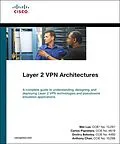A complete guide to understanding, designing, and deploying Layer 2 VPN technologies and pseudowire emulation applications
- Evaluate market drivers for Layer 2 VPNs
- Understand the architectural frame-work and choices for Layer 2 VPNs, including AToM and L2TPv3
- Grasp the essentials of Layer 2 LAN and WAN technologies
- Examine the theoretical and operational details of MPLS and LDP as they pertain to AToM
- Understand the theoretical and operational details of Layer 2 protocols over L2TPv3 in IP networks
- Learn about Layer 2 VPN bridged and routed interworking and Layer 2 local switching
- Understand the operation and application of Virtual Private LAN Services (VPLS)
- Learn about foundation and advanced AToM and L2TPv3 topics through an extensive collection of case studies
The historical disconnect between legacy Layer 2 and Layer 3 VPN solutions has forced service providers to build, operate, and maintain separate infrastructures to accommodate various VPN access technologies. This costly proposition, however, is no longer necessary. As part of its new Unified VPN Suite, Cisco Systems® now offers next-generation Layer 2 VPN services like Layer 2 Tunneling Protocol version 3 (L2TPv3) and Any Transport over MPLS (AToM) that enable service providers to offer Frame Relay, ATM, Ethernet, and leased-line services over a common IP/MPLS core network. By unifying multiple network layers and providing an integrated set of software services and management tools over this infrastructure, the Cisco® Layer 2 VPN solution enables established carriers, IP-oriented ISP/CLECs, and large enterprise customers (LECs) to reach a broader set of potential VPN customers and offer truly global VPNs.
Layer 2 VPN Architectures is a comprehensive guide to consolidating network infrastructures and extending VPN services. The book opens by discussing Layer 2 VPN applications utilizing both AToM and L2TPv3 protocols and comparing Layer 3 versus Layer 2 provider-provisioned VPNs. In addition to describing the concepts related to Layer 2 VPNs, this book provides an extensive collection of case studies that show you how these technologies and architectures work. The case studies include both AToM and L2TPv3 and reveal real-world service provider and enterprise design problems and solutions with hands-on configuration examples and implementation details. The case studies include all Layer 2 technologies transported using AToM and L2TPv3 pseudowires, including Ethernet, Ethernet VLAN, HDLC, PPP, Frame Relay, ATM AAL5 and ATM cells, and advanced topics relevant to Layer 2 VPN deployment, such as QoS and scalability.
Autorentext
Wei Luo, CCIE No. 13,291, is a technical leader for Cisco Systems. He is the principle designer and developer for Cisco Layer 2 VPN products including AToM and VPLS. Wei actively participates in IETF standarization processes.
Carlos Pignataro, CCIE No. 4619, is a senior engineer in the Escalation Team for Cisco Systems. In this role he is responsible for handling difficult and complex escalations, working on critical or stalled software defects, and participating in the new product and development process.
Dmitry Bokotey, CCIE No. 4460, holds a quadruple CCIE title in the fields of Routing and Switching, ISP Dial, Security, and Service Provider. He is a network consulting engineer with the Central Engineering and Metro Ethernet team of Cisco Systems.
Anthony Chan, CCIE No. 10,266, is a network consulting engineer for the Cisco System Advanced Services Central Engineering organization. Anthony participates in MPLS and routing technology teams, which provide focused design and proactive support to service provider and enterprise customers.
Inhalt
Introduction
Part I Foundation
Chapter 1 Understanding Layer 2 VPNs
Understanding Traditional VPNs
Legacy Layer 2 VPNs
Layer 3 VPNs
Challenges of Traditional VPNs
Introducing Enhanced Layer 2 VPNs
Summary
Chapter 2 Pseudowire Emulation Framework and Standards
Pseudowire Emulation Overview
Network Reference Model
Protocol Layer and System Architecture
Native Service Processing
Pseudowire Encapsulation Processing
Transporting over the PSN
Setting Up a Pseudowire
Pseudowire Emulation Standardization
IETF Working Groups
Layer 2 VPN Architectures on Pseudowire Emulation
draft-martini
draft-kompella
Other Layer 2 VPN Architectures
Summary
Chapter 3 Layer 2 VPN Architectures
Legacy Layer 2 VPNs
Frame Relay and ATM
Data Link Switching
Virtual Private Dial-Up Network
Any Transport over MPLS Overview
Using Label Stacking in AToM
Layer 2 Protocols Supported by AToM
Deciding Whether to Use AToM
Existing Network Installation Base
Advanced Network Services
Interoperability
Network Operation Complexity
Layer 2 Tunnel Protocol Version 3 Overview
L2TPv3 Operations
Layer 2 Protocols Supported by L2TPv3
Deciding Whether to Use L2TPv3
Existing Network Installation Base
Advanced Network Services
Interoperability
Network Operation Complexity
Summary
Part II Layer 2 Protocol Primer
Chapter 4 LAN Protocols
Ethernet Background and Encapsulation Overview
Metro Ethernet Overview
Metro Ethernet Service Architectures
Understanding Spanning Tree Protocol
Spanning-Tree Operation Overview
Drawbacks of a Spanning-Tree Implementation in Today's Networks
Pure Layer 2 Implementation
802.1q Tunneling
802.1q and 802.1p Tagging
Understanding How 802.1q Tunneling Works
802.1q Tunneling Guidelines and Restrictions
Summary
Chapter 5 WAN Data-Link Protocols
Introducing HDLC Encapsulation
Introducing PPP Encapsulation
Understanding Frame Relay
Encapsulation
Frame Relay Link Management Interface Protocol
Status Enquiry Message Frame
Status Message Frame
Update Status Message Frame
Comparing Gang of Four LMI with Annex A and Annex D
Managing Traffic
Frame Relay Traffic Policing
Frame Relay Traffic Shaping
Understanding ATM
Encapsulation
ATM Adaptation Layer
ATM Cell Structure
ATM Management Protocols: ILMI and OAM
Managing Traffic
ATM Traffic Policing
ATM Traffic Shaping
Summary
Part III Any Transport over MPLS
Chapter 6 Understanding Any Transport over MPLS
Introducing the Label Distribution Protocol
LDP Protocol Components
Discovery Mechanisms
LDP Basic Discovery
LDP Extended Discovery
Session Establishment
Label Distribution and Management
Label Binding
LDP Advertisement Message
Label Advertisement Mode
Label Distribution Control Mode
Label Retention Mode
LDP Security
Understanding AToM Operations
Pseudowire Label Binding
Establishing AToM Pseudowires
Control Word Negotiation
Using Sequence Numbers
Pseudowire Encapsulation
ATM
Frame Relay
HDLC
PPP
Ethernet
Summary
Chapter 7 LAN Protocols over MPLS Case Studies
Understanding Ethernet over MPLS Technology
EoMPLS Label Stack
Packet Format
MTU Size Requirements
Supported VC Types
Label Imposition
Label Disposition
EoMPLS Transport Case Stu…
